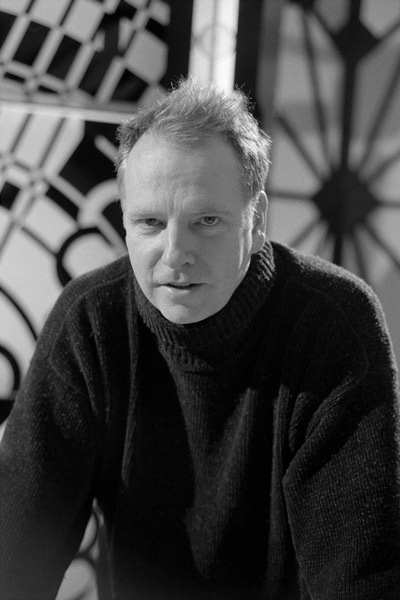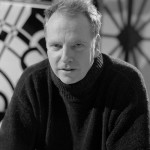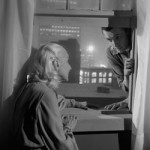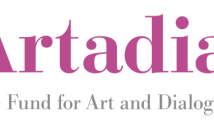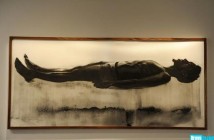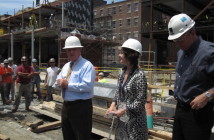Back in April I had the chance to interview Canadian filmmaker Guy Maddin. He was in town for the Independent Film Festival of Boston to screen his new film My Winnipeg. Guy Maddin has been making experimental films since the early eighties and is often referred to as the "Canadian David Lynch." He was the youngest recipient of the Lifetime achievement Award at the Telluride Film Festival way back in 1995. He currently teaches film at the University of Winnipeg. My Winnipeg won the award for Best Canadian Feature at the 2007 Toronto International Film Festival and it won the audience award at the IFFB here in Boston. It opened at the Kendal Cinema on Friday, July 11th.
James Nadeau: One of the things I have found interesting about your film is that it prompts a lot of questions.
Guy Maddin: The biggest one that comes up all the time is "how much is that true?"
JN: That is one of the things that I really loved about the film is that it really plays with the notion of the truth or even about personal history. It walks that line between being a document and being a false document where ultimately it doesn't even matter.
GM: I don't think it really matters but for the record it is true. The movie is equal parts fact, opinion -- I make no bones about it being my opinion, I write things self-pityingly -- and then legend. It's a fact that this is a local legend that some people either believe and (well, I don't believe in the para-normal personally) a lot more people in Winnipeg do than in most other cities. And a lot of people buy into the fact that because it's this mystical connection of river forks and (Winnipeg being) the actual geographical center of the continent where if God were bored with himself and just spinning North America on the tip of his finger we'd all be sitting on God's cuticle. And we all sort of walk around as if God's cuticle is being shoved up our asses. Anyway, so Winnipeg has this temperament and I have this particular temperament and I don't know…I was commissioned to make a movie about my Winnipeg not just Winnipeg. So I quickly realized that it was meant to be personal.
The Documentary Channel wanted my Winnipeg, the Guy Maddin tour. Although you know, the first year, when I made my first super-8 feature, Neil Young (also from Winnipeg) made Greendale (2003), a super-8 feature and I'm going "Damn, I didn't even make the most famous super-8 feature from Winnipeg!" But anyway what was I getting at? Just, well, I realized that if I was to make my Winnipeg that what makes Winnipeg special to me is that it is my home and then I realized that what makes it my home is that it is my childhood home. Which is so important to me. And it was there and what's a building without the family members in it so my actual family and so there all inseparable.
And so I couldn't just stop at the city. I therefore I had to include all these things and I had to include opinions and legends too. You know when you are talking about your own family it is more emotional facts that matter more then real ones. It's the myths. There is virtually no mythology about Canada or Winnipeg. And so when I was asked to make this documentary I thought here is a chance for me to fill a void. Meanwhile every family though has its own myths. You can't escape that. So here I got a chance to sort of vivisect my family and look back at people living and dead and do my city and country (by extension) and my family and myself all at once. It is a historical, mythological look. And when I say mythological I don't mean it's not true. I just mean it has been processed by the passage of time.
JN: So more the act of then?
GM: Yeah, and mythic truth is more important that facts anyway.
JN: I thought it was great that there are these two narrative lines. And it's like you are looking at the macro and the micro of family and family spaces alongside the citizen/public "personal" space. And you speak about how people inhabit private homes but also public spaces and make them identity-based spaces.
GM: Yeah, yeah. I'm glad you say that.
JN: There is the part about deconstructing that big store (I'm drawing a blank on the name)…
GM: Eaton's
JN: Yes. And how the central loss that occurs is that how timeless that space is. Because once the building is gone it is almost like people don't even remember what was there.
GM: Um, yeah. Amnesia and demolition are our growth industries in Winnipeg. (Laughs) Home is really haunting to me. I literally do have dreams about my childhood home all the time. I guess I was hoping with the movie to be so specifically Winnipeg that I would actually push through that hazy specificity. And by some miracle reach some kind of universality that people from Boston or Cleveland or Timbuktu might be able to find themselves in. Somehow, even though they no intention of ever going to Winnipeg. I've saved them the trouble.
JN: Well, I had several moments while watching the film where I asked myself if this was even a real place. Does Winnipeg really exist?
GM: Sometimes it does feel like a bit of a dream. I often think about the ideal poster, what it should be, and IFC (Independent Film Channel) is doing a great job and they have cooked up some poster that's beautiful, but I'm just thinking that some sort of icy, metropolis, just a dazzling sort of fairy land would have been nice.
JN: Like a fortress of solitude?
GM: Yeah like some sort of ectoplasm, and it would be expensive to print, but if the ectoplasm could somehow rise off of the pagers of the poster. Like a frosty breath. That would be the ultimate poster for it. It is an intoxicating thing. Especially in January. That is when Winnipeg is special. People say, "you should come and visit in the summer, that's when it is pretty" but then it is just like Milwaukee. But in the winter, that is when it is special. That's when it's as cold a city there is. Except for Ulan Bator (in Mongolia) now. I got one fact wrong in the movie. It's not the coldest city in the world. Thanks to global warming Ulan Bator has shuffled up ahead of us. But no, it is really special. And the place just seems sugar coated. And it is so cold your nostrils feel like they are being turned inside out with pliers.
JN: Can you talk about the film from a process perspective? Because the film is such a mélange of technologies. From super-8 to super-16 to HD (High Definition), mini-DV and is this…
GM: Plus cell phone.
JN: (laughs)
GM: You know I didn't use Fisher Price Pixelvision. I'm kicking myself.
JN: So is this multiplicity of medium just methodology for you? Or perhaps a way to break out of the confines of each technology?
GM: I was hoping this movie would help me break into digital technology. So I bought these HD cameras. I thought that maybe I can get comfortable, the way David Lynch really got comfortable in Inland Empire with this new technology. Maybe I can. The subject matter didn't quite allow as much HD to be used as possible. I shot a lot on HD. Some of it I incorporated into the rear screen projection, which was then later shot on film. Some of it was actually incorporated into the movie but never quite sat well so I projected the edited sequences, the finished sequences, right on to my fridge and just re-shot them with a film camera to embed them. You know it just finally seemed to make sense. The simple approach -- the past is shot on film and the present was shot on video -- it just seemed quite simple and …there was no point in trying to confound people on that level.
JN: Cause it does seem kind of counter to your aesthetic to have this fine, super high pixel HD image.
GM: Yeah, yeah and I don't know how to mess with…basically I had to learn how to un-learn cameras. I have gotten most of my atmospheric effects through screw-ups on my camera. But I haven't, these new HD cameras are kind of screw-up proof. So I have chanced upon…you actually have to master them to get good effects where I was just screwing up to get good effects before. So it's not user friendly that way. I'm not getting the love back from these cameras. Nothing special happened so not much video made it in. I'm just going to keep some video diaries and keep breaking the camera in until something good comes out of it.
JN: It's interesting in that with this film the role that the super-8 and the super-16 play, not so much with the narrative itself but within the form of the film itself is that is helps to pull in these historical moments. And it seems integral to the film to have this flicker and have the tone…
GM: Well, you know when you are talking about mythic things it seems like they should be halfway biodegraded already somehow. Not necessarily through trumped up aging but just, they should be less explicit. They should be more archetypal, more murky. A little less razor sharp revealing that's all. So I'm not trying to imitate old movies so much as removing color that has no point to make.
What difference does it make? It's winter! It's light, sky and snow. And any other color is beside the point. There's no good reason to shoot in color. As a matter of fact I am presenting the movie as a propaganda piece. I was commissioned to enchant the executive producer. He said, literally, " I want you to make a documentary that's about your Winnipeg and enchant me." I was basically given this Leni Riefenstahl-ian task of enchanting him and so whenever I think of propaganda I think in black and white terms. Winnipeg is black and white, my task was black and white and I wanted to make a snow noir. Winnipeg deserves a snow noir. So that is what I made.
JN: Did you set out to have a narrative arc at all?
GM: I did. We had to shift around the order of the anecdotes, that's all. And then about a year after I shot I had a little daydream that resulted in me having a train interior set built. And I came up with this narrative grout. This, sort of, train set and the idea…I was able to link the anecdotes together by train and since the city was built on rail…the rail industry…it seemed like the perfect solution. I love train movies and I love the sleepy, womb-like rocking that a train car gives.
JN: And some of those scenes are the most vivid and grounding of the film.
GM: It felt really good to shoot them. I was able to use a handheld camera again. Cause for rear screen projection filming you are almost always locked down to a tripod so I was able to get organic and move the lights around a lot and go in and out of focus. And just deal with spaces again. I just like close-ups more then anything else.
JN: How crucial was the voice over aspect for you?
GM: I really don't like the sound of my own voice that much. Well, I didn't at the time. Most people aren't comfortable with it. And so I really wanted Lorne Greene to do it. But he's dead. Especially since I lost my virginity to Lorne Greene narrating "Lorne Greene's Nature Wildlife Theatre." He's got such a great voice and he's Canadian and everything. So I really wanted someone like that. But my producers finally just said look no one is going to believe what's in this movie anyway, you've got to be you. Use your own voice whether you like it or not. So I was ordered by Michael Burns, at the Documentary Channel, and Jody Shapiro, my producer, to use my own voice. I had my editor cut it into like a radio show and he treated the narration like editors usually treat temp music. So, instead of cutting to music to get the rhythm of the film, he cut to my narration.
JN: . . . and you do the voice over live at some screenings don't you?
GM: I have done it live. I did it in New York at Tribeca, I did it in Berlin and Toronto and I am going to be doing it at the screenings in Sydney and London. I can't wipe the smile off my face thinking of these live presentations. It was a gala presentation at the Film Forum at the Berlinale. I could not get the smile off my face. I hate performing but it was so worth it. I got to do a travelogue on Winnipeg.
JN: So to finish up, your filmmaking style has been referred to as "Postmodern Expressionism" and links it back to the German Expressionism. Do you feel that is appropriate?
GM: I like the idea of expressionism, the simple definition, you know, just an interior landscape expressed in the exterior. It seemed simple enough to me. It gave me a really simple strategy for set design.
JN: Lots of shadows?
GM: Yeah! Shadows are cheap and they produce a lot of atmosphere. You know, you can't afford more décor then lets add more shadows! Unplug another light. I like the economy, the atmosphere and it also gives you permission to manner your performances closer to dance or opera. I'm comfortable with it. And you know I had to have someone define just what post-modern was and it seems that is just isn't a term that is relevant anymore.
- Guy Maddin
- A still from My Winnipeg
All images are courtesy of the artist.

